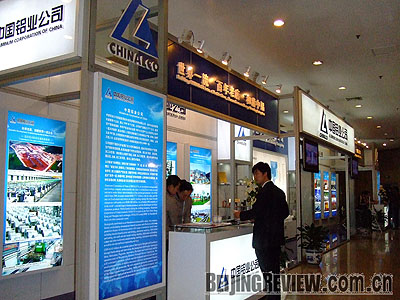|
|

ANOTHER VICTIM: Chinalco, China's top aluminum maker, recently slashed its annual production capacity by 38 percent in response to falling prices and demand (LIU XINLIAN) |
Several unfavorable factors have borne down on China's powerful nonferrous metal industry, presenting grim challenges for the sector and appearing to signal the end of the country's booming demand for nonferrous products.
During the last three years, surging metal prices, supply shortages and huge returns on investment made the nonferrous industry highly profitable as well as speculative. Now the industry seems to have taken a turn for the worse.
Attracted by the prospects of huge profits, an increase of investment in the nonferrous metal sector compelled companies to boost their output capacities, resulting in heavy oversupplies. When China's nonferrous metal suppliers were able to meet or exceed demand, prices plunged sharply. Now the U.S. financial crisis has made the situation even worse: As China's exports have sagged, so has foreign demand for the country's nonferrous metals. Facing below-cost prices and sluggish markets, the country's nonferrous enterprises have had to cut production.
Winter falls
Take, for example, NFC Kumba Hongye Zinc Corp. (NKZC) based in the city of Chifeng in the Inner Mongolia Autonomous Region. With an estimated annual output of 110,000 tons, NKZC is about at the intermediate level of China's zinc industry. NKZC had been purchasing zinc concentrate at 9,000-10,000 yuan ($1,318-1,464) per ton, but zinc was selling for 9,600 yuan ($1,405) per ton on the Shanghai Futures Exchange on November 25.
"The price is so bad now that we have reduced output by more than 30 percent," said Xiao Qian, Representative of South Africa-based Exxaro Resources Ltd.'s Beijing Office, which is NKZC's major shareholder.
The company's reduced production has led to job cuts. Now some employees have left their positions temporarily and are receiving only half their salaries.
If zinc prices do not rise by the Chinese Spring Festival on January 25, the company will not be able to restore its production to its previous level and will strive to develop a longer-term solution for its workers, Xiao said.
On November 14, Huludao Zinc Industry Co., the country's second biggest zinc producer, said it was cutting its production by 105,000 tons, or 27 percent of its total annual production capacity, because of the sluggish demand for zinc and short supply of zinc concentrate.
"In order to reduce costs, zinc producers are trying to force zinc concentrate prices down," Xiao said. "Thus the zinc miners are not willing to produce."
Other zinc refineries have also been shutting down, because the industry is quite fragmented, said Qi Lin, Manager of zinc-china.com, a Tianjin-based professional website for the zinc industry.
"Now the cost [of production] is higher than the [selling] price," Qi said. "Production means loss; the more products they produce, the more losses they suffer."
China is the biggest zinc producer in the world as well as the largest zinc consumer. Galvanized sheets, used in automobiles, consume most of the country's zinc. While galvanized sheet exports have slowed since October 2007, domestic automobile output has dropped sharply since this February, causing deceased demand for zinc, Xiao said.
Zinc is not the only metal that is suffering from a sluggish market. China's top aluminum maker, Aluminum Corp. of China Ltd. (Chinalco), the world's third largest producer of aluminum, issued a statement on November 6, saying that it would slash its annual production capacity of 4.11 million tons, or by 38 percent. Between January and September, 22 major aluminum producers in China witnessed a 37-percent decrease year on year. They saw a combined loss of 900 million yuan ($132 million) in September alone, according to figures issued by the China Nonferrous Metal Industry Association.
Copper prices also have plunged since July, prompting a 40-percent drop in the country's overall production. Copper prices on the Shanghai Futures Exchange had fallen 47 percent to 33,000 yuan ($4,832) a ton in mid-November. The production scale back would result in a reduction of about 120,000 tons of copper this year, according to a Reuters report. Companies are decreasing their output capacities by about 2 million tons from the normal 4.6 million tons annually, Reuters said.
Aluminum prices in China also have been sliding dramatically this year, dropping 22 percent to 13,520 yuan ($1,980) a ton in mid-November on the Shanghai Futures Exchange, compared to the price three months ago.
Inner and outer dilemmas
Many industry insiders and experts agree that the volatility of the global economy, namely the U.S. financial crisis, has triggered China's current slowdown in the nonferrous metal industry. Base metals, such as copper and aluminum, whose prices depend greatly on the financial situation, are closely linked with the fictitious economy-securities, futures and financial derivatives transactions-and the real economy.
As the subprime mortgage crisis deepens in the United States and worldwide, investors are losing confidence in a great majority of commodities and are withdrawing from the market, said Zhao Wuzhuang, Chief Economist of the China Institute of Nonferrous Metals Technology and Economics at the 10th China Mining Expo held in Beijing on November 11-13. He went on to say that as a result, the value of global commodities such as oil derivatives and nonferrous metals is collapsing along with China's nonferrous metal market.
|
